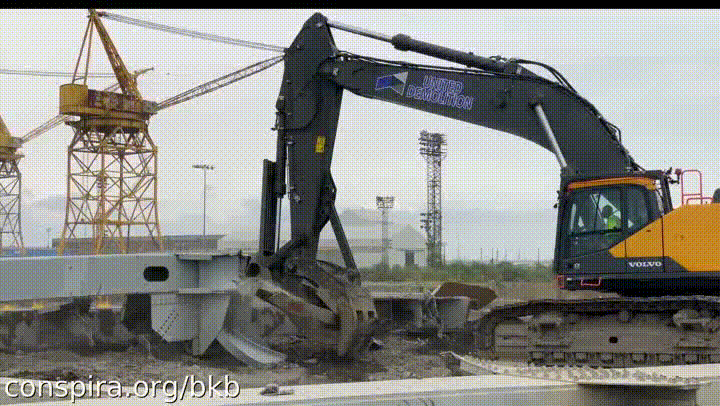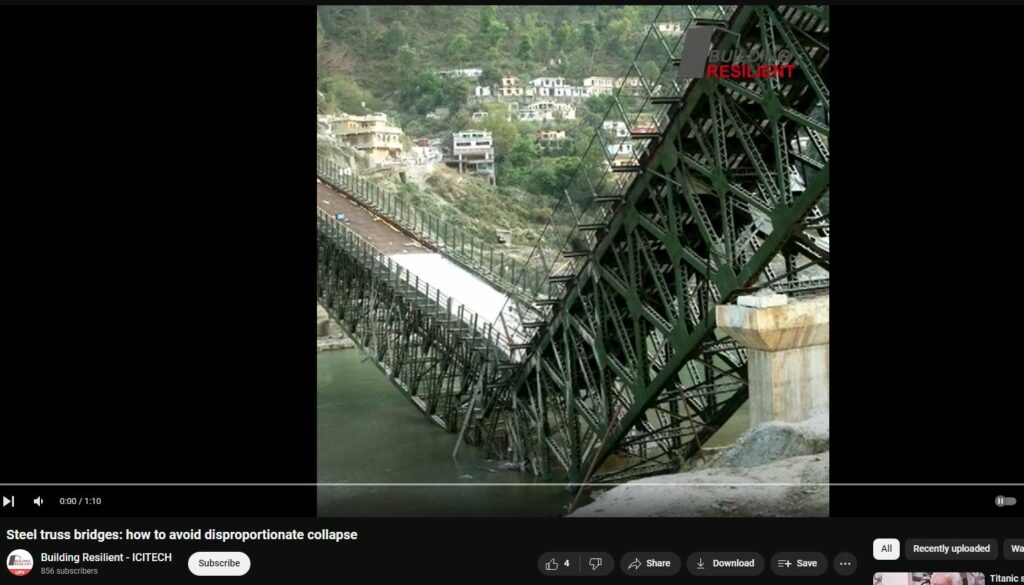“This was a trillion-dollar costly event, ongoing, and yet all culpable persons remain unnamed, kept totally anonymous, with some reportedly having been slyly ‘escaped’ from the country! There is, in fact, zero publicly-verifiable evidence that any genuine Captain, Pilots or Crew ever existed; was DALI a remote-controlled ghost-ship on kamikazee mission from its outset? No waves nor sounds at all were recorded nor reported by any nearby persons nor cameras. No interviews exist with supposed survivors; “family and friends” etc interviews reveal ‘dupers-delight’ micro-facial-expressions with other hallmarks suggestive of fraud. Rampant is the extremely suspicious damage with blatantly visible, verifiable anomalies totally inexplicable (and ignored) by official theory or story. Grand payola galore is already underway with loads more coming. This is another audacious yet sublime crime, militarized from gov to salvage to rebuild. There was no rescue skiff on scene as required by OSHA. No horn blasts from ship warned of imminent collision. The ship departed despite dire electrical problems, illegal at any time and even more highly unusual in the cold, dark night-time (part #94, first ‘after-sundown departure’ in two years). Criminal was this manufactured event, through and through, and that’s before considering the absurdly high number of other anomalies including the complicit, worthless, ‘kept-pet’ mass-media…”
Part #91 adapted from a video comment
Index . Oddity List . Official Story . Summary
Steel cracks and shatters during dredging; it does not bend, warp, wilt, deform or distort without heat
BELOW: Watch the sturdy structural steel fracture and shatter, “rip apart” BUT NOT bending. Bending, warping, wilting requires superheating which is caused by Directed Energy Weapons. The steel was superheated and wilted before and during the collapse; afterwards, it’s back to normal, as expected. Below is evidence that the bridge steel is in fact rigid and does not bend, distort, warp or wilt.

“…so they tried to pull up this giant piece and part of it just kind of ripped apart under its own weight and fell back down” — NONE OF THE GIRDERS BENT — so why are there so many bent girders to begin with ??”
4:20 into https://www.youtube.com/watch?v=XJHSfo2SLw8
The most obvious answer is the steel “ripped apart” because it was not molten by Directed Energy Weapons.
2024-0610
Interwoven Steel Girders, Impossible without DEW

Other examples of steel truss bridges collapsing
Steel Not Bending
Steel Truss Bridge Collapses Near Canso Nova Scotia – 7 July 2020

NO BENDING

The Science Behind Structural Steel Girders: Durometer, Hardness, and Heat
Structural steel girders are the backbone of modern construction, forming the skeletal framework of skyscrapers, bridges, and other massive infrastructure projects. Understanding the properties of these girders, particularly their durometer and hardness scales, is essential for grasping how they behave under various conditions.
Durometer and Hardness Scales
The durometer is a measure of a material’s hardness, which in the context of structural steel, indicates its resistance to permanent indentation. The hardness of steel is typically measured on scales such as Rockwell, Brinell, or Vickers, each suited for different applications and providing insights into the material’s strength and durability. High hardness in steel means it is very resistant to deformation, but this also means it can be more brittle, especially in cold conditions.
Cold Steel Behavior: Cracking and Shattering
One of the critical properties of cold steel is its tendency to crack and shatter rather than bend. This brittleness occurs because steel’s atomic structure becomes less flexible at lower temperatures, making it more susceptible to fractures under stress. Without the introduction of external heat, steel does not bend easily; it maintains its shape until the applied force exceeds its structural limits, leading to cracks or complete breakage.
The Role of Heat: From Blast Furnaces to Directed Energy
To form structural steel into permanent shapes and structures, immense heat is required. This heat is typically provided by blast furnaces, which can reach temperatures up to 1,800 degrees Fahrenheit (982 degrees Celsius) or more. At these temperatures, the atomic structure of steel becomes more malleable, allowing it to be shaped, bent, and formed into the desired configurations without breaking. The superheating process is essential for creating the precise angles and bends seen in modern construction.
However, outside the controlled environment of a blast furnace, there are very few heat sources capable of causing structural steel girders to melt and deform. One such source is directed energy weapons (DEWs). These devices can focus a large amount of energy on a small area, raising the temperature of steel to its melting point almost instantaneously. DEWs induce eddy currents in the steel, causing rapid heating due to the electrical resistance within the material. This process illustrates the extreme conditions required to significantly alter the structure of steel outside of conventional manufacturing processes.
Tight-Radius Bends and Heat-Induced Deformity
Achieving crack-free, tight-radius bends in steel girders is only feasible with the application of substantial heat. When steel is heated, its crystalline structure loosens, and it can be bent or molded without the risk of cracking. This process is crucial for creating the complex shapes needed in modern architectural designs. Without this heat, attempting to bend steel to a tight radius would almost certainly result in fractures and failure of the material.
In summary, the unique properties of structural steel, such as its hardness and behavior under stress, highlight the importance of heat in its manipulation and use in construction. Blast furnaces provide the necessary temperatures to shape steel girders effectively, while the use of directed energy weapons showcases the extreme conditions needed to replicate these effects outside traditional methods. Understanding these principles is fundamental to appreciating the engineering marvels that structural steel makes possible in our built environment.